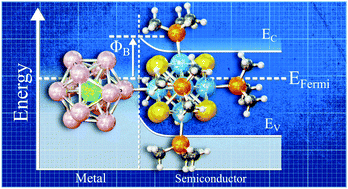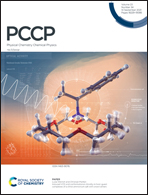Massive dipoles across the metal–semiconductor cluster interface: towards chemically controlled rectification†
Abstract
An interface between a metallic cluster (MgAl12) and a semiconducting cluster (Re6Se8(PMe3)5) is shown to be marked by a massive dipole reminiscent of a dipolar layer leading to a Schottky barrier at metal–semiconductor interfaces. The metallic cluster MgAl12 with a valence electron count of 38 electrons is two electrons short of 40 electrons needed to complete its electronic shells in a superatomic model and is marked by a significant electron affinity of 2.99 eV. On the other hand, the metal-chalcogenide semiconducting cluster Re6Se8(PMe3)5, consisting of a Re6Se8 core ligated with five trimethylphosphine ligands, is highly stable in the +2 charge-state owing to its electronic shell closure, and has a low ionization energy of 3.3 eV. The composite cluster Re6Se8(PMe3)5–MgAl12 formed by combining the MgAl12 cluster through the unligated site of Re6Se8(PMe3)5 exhibits a massive dipole moment of 28.38 D resulting from a charge flow from Re6Se8(PMe3)5 to the MgAl12 cluster. The highest occupied molecular orbital (HOMO) of the composite cluster is on the MgAl12 side, which is 0.53 eV below the lowest unoccupied molecular orbital (LUMO) localized on the Re6Se8(PMe3)5 cluster, reminiscent of a Schottky barrier at metal–semiconductor interfaces. Therefore, the combination can act as a rectifier, and an application of a voltage of approximately 4.1 V via a homogeneous external electric field is needed to overcome the barrier aligning the two states: the HOMO in MgAl12 with the LUMO in Re6Se8(PMe3)5. Apart from the bias voltage, the barrier can also be reduced by attaching ligands to the metallic cluster, which provides chemical control over rectification. Finally, the fused cluster is shown to be capable of separating electron–hole pairs with minimal recombination, offering the potential for photovoltaic applications.



 Please wait while we load your content...
Please wait while we load your content...